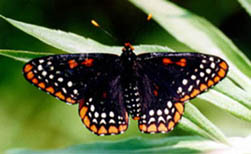This summer I have been interning at the Sierra Club, Maryland Chapter. As the club’s stewardship intern, I work to remove and organize removals of invasive plants from parks throughout Prince George’s County. My current experience has taught me that invasive plants are a serious problem and threat to Maryland’s native flora. Many of these invaders can form monocultures, completely blocking sunlight and space from the native species. Invasive plants tend to be good at colonizing disturbed and edge habitats, allowing them to outcompete the native species for resources. With no native predators to control these invaders, they can quickly establish, thrive, and take over entire ecosystems. This results in a major decline of native species, which threatens the survival many animal and insect species that rely on native flora for habitat and food.

Baltimore Checkerspot Butterfly. Photo by Mark S. Garland, Audubon Naturalist Society, retrieved from the Maryland State Archives.
One species of plant that is native to Maryland that is on the decline is the White Turtlehead. The decline of the White Turtlehead has led to the disappearance of the Checkerspot Butterfly, which relies almost exclusively on the White Turtlehead as a food source during its caterpillar stage2.. Currently, the Checkerspot butterfly can only be found in select parts of Western Maryland. The previous habitats like PG County parks, where this butterfly once existed, have completely lost the presence of the Checkerspot.
The White Turtlehead grows in wetlands. It tends to grow on the edge of the habitat and grows in sunlit and shaded areas alike, leaving it vulnerable to many invasive species. Current species that are threatening the White Turtlehead and that are taking over are hairyjoint grass, reed canary grass, common reed, Japanese stiltgrass, purple loosestrife, Japanese honeysuckle, multiflora rose, and mile-a-minute 1. All of these species outcompete the White Turtlehead for resources and are leading to a massive decline of this plant statewide. As a result, the caterpillar of the Checkerspot butterfly does not have any food to feed on in the early stages of its life and cannot survive in areas where the White Turtlehead has been lost.
Fortunately, there is hope to bring back the Checkerspot Butterfly to parks in Maryland where is once existed. The first step is to reintroduce the White Turtlehead into local parks where it has been lost. In order to successfully reintroduce the White Turtlehead, the invasive species that threaten it must be controlled. This can be done through manual removal by teams going out into the parks and physically cutting and pulling these plants. There are also chemical controls like herbicides and some biological controls as well. In fact, a biological control has already been introduced for one invader, mile-a-minute, which threatens White Turtlehead in Maryland. A species of weevil has been introduced to several parks containing mile-a-minute and has been eating and controlling those populations. With more support, funding, and outings, it is possible to eradicate enough invasive species to successfully reintroduce the White Turtlehead. When the White Turtlehead is reintroduced, we can begin to reintroduce the Checkerspot Butterfly to our parks. Hopefully one day all of Maryland will once again be able to experience the Baltimore Checkerspot Butterfly throughout the state.
With support from local communities and government, there is the potential for a major impact on the invasive plants that are causing a loss of the Checkerspot. However, invasive species are not the only threat. Global warming is also causing a decline in the Checkerspot and White Turtlehead. As a community, we must continue to take action against global warming and invasive species, because the Checkerspot Butterfly is not the only animal disappearing from our state. We must preserve the natural ecosystem and species we have in Maryland and across the country before they are lost forever from our forests and parks.
References:
1. http://www.dnr.state.md.us/wildlife/Plants_Wildlife/BCRT/pdfs/2013_Plan_ConservationBaltimoreCheckerspot.pdf
2. http://dnr2.maryland.gov/wildlife/Pages/plants_wildlife/rte/rteanimalfacts.aspx?AID=Baltimore%20Checkerspot
3. http://wildmaryland101.blogspot.com/2012/09/maryland-flora-white-turtlehead-chelone.html